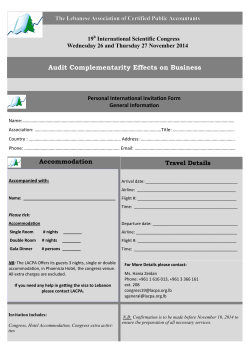
Growth in Student Population and Declining Housing
Sustainable Neighbourhoods: Growth in Student Population and Declining Housing Affordability Presenter: Nnenna Ike PhD Candidate, University of The Sunshine Coast, Queensland Australia) AHRC 2015 Conference –Housing Futures, Transforming Living, Changing Lives February, 2015 The Study in Context • Growth in population- In the past six decades, the Australian HE sector has undergone significant changes with significant increase in enrolment by both domestic and overseas students (Bradley et al., 2008, Australia Universities, 2013a). • Limited university-provided housing spaces - Australian universities provide accommodation for about 5% of the nation’s over 1,000,000 students (Earp, 2010). • Influx of students into the private rental market- Logically from point 2 above, 95% of the student population are either in the private rental market or living at home. This can put pressure on the private rental housing (Susilawati and Armitage, 2004). • Decline in affordable housing- Often, it is difficult for students to find affordable housing within reasonable distance of university campuses, in both inner cities and regional areas (Universities Australia, 2014) as ‘housing affordability in Australia has deteriorated substantially in the last twenty years’ (O’Neill et al., 2008 pg. 9). Definition adopted in this study: Housing is said to be affordable if it is of a standard that may be considered adequate (safe and suitable) and does not cost the individual more than 30% of their income such that they are still able to meet their other basic living costs on a sustainable basis (Yates and Milligan, 2007). 2 Theoretical Framework of the Study SUSTAINABLE NEIGHBOURHOODS GROWTH IN STUDENT POPULATION DECLINE IN AFFORDABLE HOUSING STUDENTIFICATION: A process arising from the (over) concentration of students living in an area (neighbourhood); leading to the formation of “student areas or enclaves” in traditionally non-student neighbourhoods (Smith, 2002) LIMITED UNIVERSITY HOUSING INFLUX INTO THE PRIVATE RENTAL MARKET 3 THEORETICAL UNDERPINNINGS OF STUDENTIFICATION Over-concentration of students in university neighbourhoods can lead to economic, physical, social and cultural changes based on students’ unintentional activities in the neighbourhood (Smith, 2008, 2009; Hubbard, 2008; Rugg et al., 2010; Pickren, 2012; Anderson, 2013). Local residents perceive this as either positive or negative. Where negative, it can lead to resentment towards the students as well as impact the community’s sustainability (National HMO Lobby, 2008). Economic Changes Social Changes Students can be perceived as voracious consumers of alcohol leading to drink-fuelled violence and vandalism Spending in the local economy creates spin-offs for restaurants, groceries, clubs, pubs, sporting events and facilities bringing commercial vibrancy during term-period Cultural Changes Physical Changes Unkempt properties, indiscriminate rental adverts, squalor and dereliction which may cause permanent street blight and unsightly extensions Their diverse background can enrich community life and bring about diversity in dressing, food and music 4 RESEARCH AIMS How can safe, affordable and suitable student housing be provided for students, who are an identifiable segment of the Australian housing market? How can sustainable communities/neighbourhoods be achieved or promoted by the various stakeholders (Government, university administration, property developers and investors, local community and urban planners) against the backdrop of a high number of students living in non-university accommodation? WHAT ARE THE KEY QUESTIONS? 1. What trend exists in student accommodation provided by Australian universities located in urban and regional areas? 2. What are the factors students consider and the trade-offs they make when deciding on accommodation? How can this inform a suitable student housing design model? 3. What are the impacts of students’ accommodation in university neighbourhoods and how can this inform policy? 4. What are the institutional and non-institutional factors that influence the supply of student housing? How can planning policy be used to influence the supply of affordable student housing? 5 METHODOLOGY Mixed methods and two case studies of different sized regional universities: 1. University of the Sunshine Coast (USC), Queensland 2. University of New England (UNE), New South Wales Key Questions Type of Data to be Collected Desktop Analysis What trend exists in student accommodation provided by Australian universities located in urban and regional areas? Quantitative What are the factors students consider and the trade-offs they make when deciding Quantitative on accommodation? How can this inform a suitable student housing design model? Qualitative What are the impacts of students’ accommodation in university neighbourhoods and how can this inform policy Qualitative Method Desktop analysis of universities provided bed spaces across the 39 universities in Australia Telephone interviews with an officer from Student Services of 15 universities Online survey of USC and UNE students Semi-structured interview of USC students using Photo Voice Semi-structured interviews of local residents in focus groups What are the institutional and non-institutional factors that influence the supply of Document Analysis Analysis of existing state housing policies and planning student housing? How can planning policy be used to influence the supply of instruments affordable student housing? Qualitative Semi-structured interview of key stakeholders (policy and planning official, rental property developers, not-forprofits, and university authority) 6 CONCLUSION A significant number of studies have been carried out about housing affordability and the Australian housing sector (Gabriel et al., 2005, Yates and Gabriel, 2006, Yates and Milligan, 2007, Dockery et al., 2010, Lovering, 2013, Rowley et al., 2014, SCHAA, 2008, Gilmour and Milligan, 2008, Beer et al., 2006, Burke et al., 2007, Meen and Andrew, 2008). Nonetheless, there is limited literature on student housing affordability as a subset of the broader housing sector. This study, in exploring student housing as an identifiable and growing sector of the Australian housing market, offers original and practical applications by advancing: student housing design models to address the housing affordability issue experienced by students. This will provide useful knowledge on how to increase the student housing supply stock. theories on studentification and its relational role to neighbourhood changes. This can be used to inform policy and planning approaches that enhance student and community well-being. 7
© Copyright 2025













